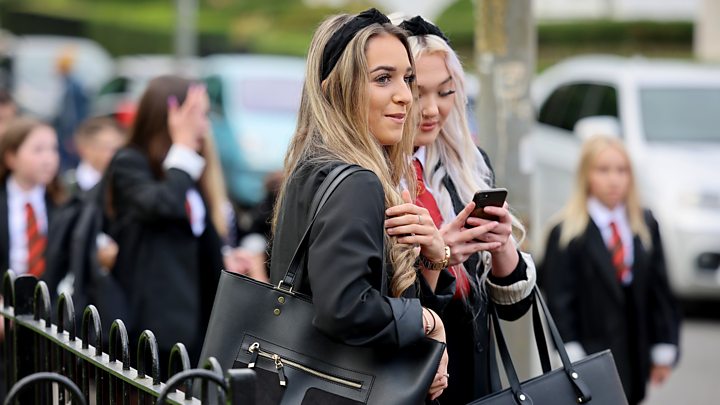Millions of pupils in England are returning to school after the unprecedented shutdown linked to the coronavirus pandemic.
Schools will look different, with one-way systems, screens keeping pupils apart and staggered start times.
Many pupils will be given inductions so they understand the new rules, such as staying in their “bubble” groups and where to use social distancing.
Teachers will assess how much pupils need to catch up after a long absence.
Godsway Dzoboku, principal of Outwood Academy Portland, in Worksop, Nottinghamshire, has re-organised classroom desks into rows, with each child being given a personalised pack of rulers, pens and other classroom equipment.
“The only way we can make bubbles work is to keep them [the pupils] in year groups – so we have a bubble of 300,” Mr Dzoboku said.
Each bubble will stick together, go to a staggered lunch and a staggered break together, he added, and each group has been allocated a corridor within the school in which they will stay and be taught.
It has been almost six months since schools were closed by the Education Secretary Gavin Williamson.
They soon reopened to vulnerable pupils and key worker children, but only a fraction of the national school population returned to any form of face-to-face lessons over the summer term.
The rest were required to carry on learning from home, but levels of support and interactive teaching have been very different from place to place.
It is not clear how many parents are planning to send their children back, although attendance is compulsory in England.
Mary Bousted, joint general secretary of the National Education Union said that, thanks to the preparations by school staff, “the signs are at the moment that it’s a very calm and managed and positive return”.
“There will be lots of nervous children and young people this morning,” she said. “I’m sure when they get into school they will be reassured by the routines and be really glad to be back with their teachers and their friends.”
But teachers and head teachers have criticised the lack of funding for safety measures, such as hand-washing stations, sanitiser, and screens.
Association of School and College Leaders general secretary Geoff Barton said it was “hugely disappointing” that these changes had to be paid for out of “hard-pressed budgets”.
England’s schools minister Nick Gibb has said funding for safety measures is “under review”, although Ms Bousted said the government was acting too slowly.
Mr Gibb has also urged parents to send their children back to school to help them to catch up on what they have missed, saying: “Schools are doing everything they can to make sure that their pupils and their staff are safe.”

Media playback is unsupported on your device
Some recent polls suggest families are keen to see children back in class but others have not been so positive.
In Scotland, where pupils returned several weeks ago, official statistics show one in 10 pupils is absent, although ministers and teachers have suggested cold and flu viruses are mostly to blame.
‘No hugs’
Mother of two, Sally, has a chronic form of blood cancer and has been shielding since March.
She told BBC Radio 4’s Today Programme she was keen for her children to get back to school to continue their education and see their friends.
“But I do have concerns that it’s exposing me to additional risks.
When they return home school, she said: “I won’t be giving them a hug, unfortunately – I’ll be keeping my distance as much as I can, otherwise it will be life as normal, hopefully.”
Pupils in Northern Ireland have already returned, and those in Wales are returning later this week.
Speaking in the Commons on Tuesday, Mr Williamson said: “Welcoming pupils back will be a massive milestone for schools across the country.”
But he faced criticism for having failed to realise the system he approved for exam grading was not fit for purpose.
The mass return comes as senior figures at England’s exams regulator, Ofqual are due to appear before the Commons education committee.
They will be answering questions on how things went so wrong with the moderation system based on a mathematical algorithm.
Pupils returning to secondary schools, will find whole sections of school buildings cordoned off to some groups, but open to others as head teachers strive to keep groups apart.
And there will be reduced movement of pupils around schools, with classes and year groups staying in a small number of rooms, while their individual subject teachers come to them to teach.
Pupils can be required to wear face coverings in busy areas, such as corridors, and lessons like physical education will be very different, with all contact sports still banned. Many will already be wearing face coverings on public transport to school.
There have been widespread concerns about pupil well-being during lock down and how this might impact attendance, ability to learn and behaviour once schools return.
And there are fears about further local school closures as cases of Covid-19 are on the rise again particularly in some areas of the Midlands and north-west England.
The rules state that when a school discovers a positive case, it will work with local health officials to assess how many other pupils should go home and isolate.
It could be just those who have been in close contact with the pupil, or an entire “bubble” group, which could be an entire year group in secondary schools.
Tell us about your return to school. Email haveyoursay@bbc.co.uk
